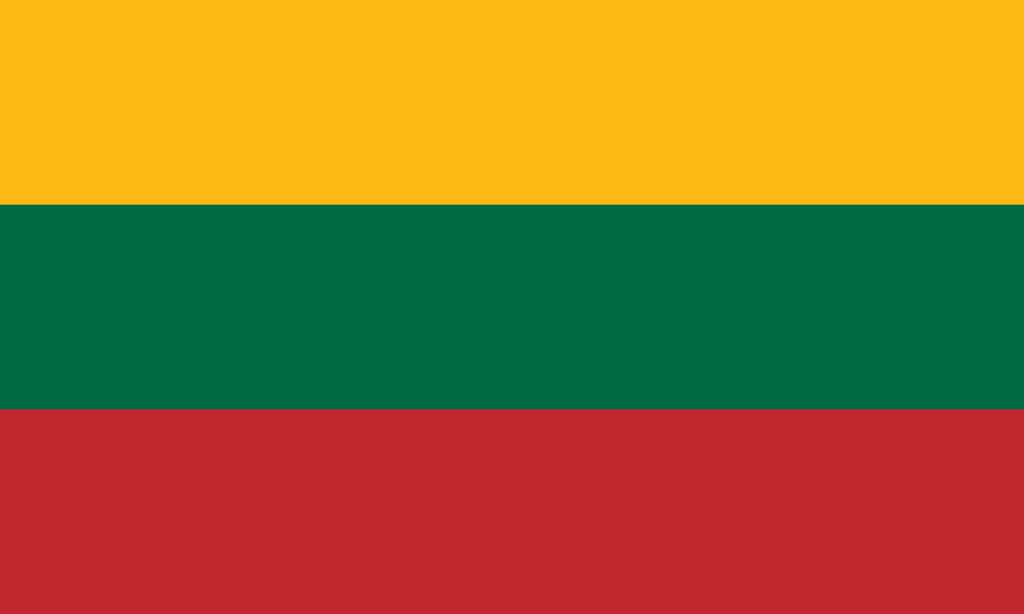Design and Arrangement:
The flag of Lithuania is characterized by its three horizontal stripes of uniform width, positioned from top to bottom. The sequence of colors comprises yellow, green, and red. The flag adheres to a typical proportion of 3:5, where the width spans three units and the length extends over five units.
Historical Development:
The contemporary Lithuanian flag finds its origins in historical banners and the rich tradition of heraldry. Its inception draws inspiration from the Grand Duchy of Lithuania, a formidable medieval entity encompassing parts of present-day Lithuania, Belarus, Ukraine, and Poland. The flag's configuration pays homage to the heraldic hues linked with the Grand Duchy's coat of arms.
Symbolic Representations:
Yellow (Auksinis): The radiant golden yellow positioned at the flag's zenith encapsulates an array of positive concepts, including prosperity, illumination, solar energy, and optimism. This hue acts as a beacon, symbolizing the ambitious aspirations of Lithuania towards a luminous and promising future. Furthermore, it resonates with the nation's bountiful agricultural landscapes.
Green (Žalias): The profound green stripe in the middle carries profound symbolism, representing Lithuania's verdant forests, fertile expanses, and innate natural beauty. This shade underscores Lithuania's steadfast dedication to ecological sustainability, while simultaneously honoring its robust agrarian heritage and rural traditions.
Red (Raudonas): The vibrant red band at the base is laden with historical and emotive significance. It serves as a testament to courage, valor, and the unwavering resolve of the Lithuanian populace to safeguard their homeland. Additionally, this crimson hue pays tribute to the sacrifices borne during myriad struggles for autonomy and self-determination.
Historical Importance:
Although the tricolor design of the Lithuanian flag was formally adopted on March 20, 1989, during Lithuania's process of reestablishing independence from the Soviet Union, its roots extend much deeper. Tracing back to the 17th century and quite possibly earlier, this design gained prominence in the 19th century, coinciding with Lithuania's national awakening. It experienced a revival as a symbol of independence in the early 20th century.
National Identity and Unity:
The flag functions as a living emblem of national identity and unity, serving as a visual manifestation of shared values, historical narratives, and collective aspirations among the Lithuanian populace. It stands as a potent reminder of the nation's triumphs and challenges, fostering a sense of pride and interconnectedness among its citizens.
Variations and Usage:
While the horizontal tricolor configuration is the most ubiquitous rendition of the flag, certain adaptations include the integration of the state emblem. Recognized as the Vytis or Pahonia, this emblem features a mounted knight brandishing a raised sword and protective shield. It encapsulates the preparedness of the Lithuanian people to defend their freedom and territory.
Flag Day:
February 16th holds special significance as the "Day of the Restoration of the State of Lithuania." It was on this pivotal day in 1918 that Lithuania reclaimed its autonomy from the clutches of the Russian Empire. The flag assumes a prominent role during national holidays, official ceremonies, and communal gatherings, standing as a tribute to this historic milestone.
Contemporary Significance:
In the present era, the Lithuanian flag stands as an emblem of both recognition and respect on the global stage. Its presence is felt across governmental edifices, public squares, and private residences, adorning the landscape during diverse celebrations and commemorations. Beyond its physical display, the flag's design has permeated Lithuania's cultural and artistic domain, adorning clothing, artistic creations, and diverse forms of media.
In essence, the Lithuanian flag encapsulates the intricate tapestry of the nation's historical journey, enduring spirit, and aspirations towards an amalgamated and prosperous future. Rooted in its vibrant colors and symbolic configuration, the flag serves as an intimate embodiment of Lithuania's intrinsic identity, rendering it an invaluable and cherished emblem for its citizenry.
Last Updated on: November 13, 2025
